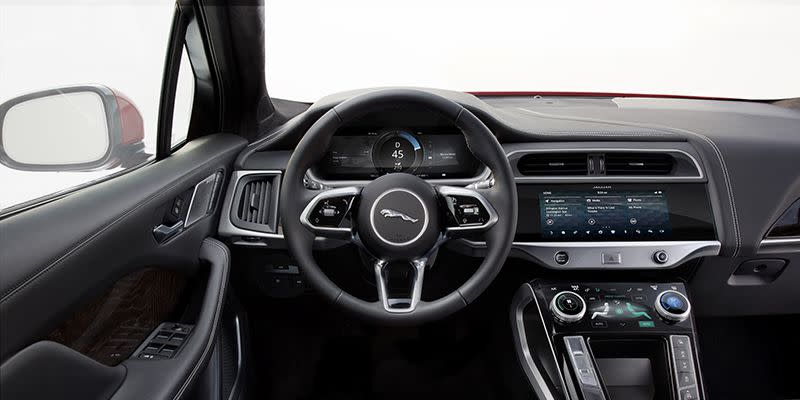Here’s How Self-Driving Vehicles Might See beyond the Curve Ahead

Autonomous and connected vehicles have largely been on parallel development paths for the past few years, with software engineers honing their self-driving systems and automakers laying digital pipelines into new cars.
Now, those paths are starting to merge. In perhaps the first project of its kind, Jaguar Land Rover is partnering with INRIX, a provider of real-time transportation analytics, and others to figure out how to use cloud-based data to augment autonomous navigation through tricky traffic situations.
The two companies have been awarded a $6.4 million grant from the U.K. government’s Centre for Connected and Autonomous Vehicles for the two-and-a-half-year project. Together, they’ll seek out ways to provide information on conditions just beyond the range of the onboard sensors, like cameras, radar, and lidar, that are essential for helping autonomous vehicles determine the best path ahead.
While the connected systems won’t provide information that’s mission critical to autonomous operations, they will add historical, real-time, and predictive data that the cars can use to better prepare for more challenging situations.
“I think we’re just beginning to crack the surface of how vehicle connectivity is going to allow highly automated vehicles to operate more effectively and efficiently,” said Avery Ash, INRIX’s autonomous-vehicle lead.
Joining Jaguar Land Rover and INRIX in the partnership are suppliers Ricardo and Siemens Transport, the University of Warwick, and governmental agencies Highways England and Transport for West Midlands. They’ll start with roughly a dozen cars that will operate on both highways and in urban areas in the West Midlands.
With a mix of public, private, and academic partners, together they can study what’s needed in the cars and traffic infrastructure to make these systems widespread in the future. They’re calling this partnership AutopleX, and while it’s currently scheduled to last 30 months, they anticipate a longer-term relationship.
The AutopleX Agenda
One of the first traffic situations they’ll examine together is how automated vehicles travel through roundabouts-where self-driving systems may have more difficulty detecting what’s around a continuous curve. INRIX will supplement the onboard sensors by providing historic speed profiles at those roundabouts. Further, the company will dispense information on road hazards and other potential problem areas, such as whether lane markings are adequate for the purposes of detection. Later, they may provide weather information that lets vehicles know, for example, the likelihood of encountering ice ahead.
Much of the information is either the same as or similar to what INRIX has already been preparing for the commercial trucking industry. Now it’s the sort of insight that can help JLR’s automated vehicles identify upcoming road and weather conditions that will improve self-driving cars’ performance and optimize routing. Should a vehicle understand there’s a high likelihood of black ice on the road ahead, for example, it could do more than hunker down the way a human might.
“You’d allow the Jaguar Land Rover vehicle in this case to be prepared, and that doesn’t mean being on edge like a driver,” Ash said. “It’d mean you have a mile and a half to adjust the speed at which you’re traveling, adjust the lane you are traveling through, or adjust your route.”
The data could also benefit human drivers. There’s great anticipation that traffic safety can be significantly improved by providing similar information on road hazards and weather conditions through vehicle-to-vehicle (V2V) and vehicle-to-infrastructure (V2I) systems even before cars drive themselves. In the United States, a potential federal mandate for such V2V connected systems has been stalled within the Department of Transportation for the past 13 months.
With that sort of information not even in the dashboards for most human motorists, the prospect that it could help fleets of deployed autonomous vehicles is on a considerably longer timeline; it’s a glint in the eye of self-driving-vehicle engineers.
But once that day arrives, they have considered the possibility that information from a connected V2V system could be fed to path-planning algorithms and be fused with information coming from lidar, cameras, and radar sensors. This project might be the first public-road project to attempt such an integration.
For Jaguar Land Rover, it marks another milepost in the luxury automaker’s push into automated technology. In 2017, the automaker invested $25 million in ride-hailing service Lyft and provided the company with a fleet of vehicles for self-driving tests. Separately, JLR announced earlier this year that it will provide Waymo with self-driving iterations of the I-Pace electric crossover for their operations.
With those rider-network and technology partnerships in the fold, Jaguar Land Rover now will attempt to harness the power of big data.
Jaguar Land Rover Plans Test Fleet for Connected and Autonomous Tech
INRIX Study: Some Cities Are Better Suited for Self-Driving Vehicles
“This project is crucial in order to bring self-driving cars to our customers in the near future,” said Chris Holmes, connected- and autonomous-vehicle research manager at Jaguar Land Rover. “Together with our AutopleX partners, we will empower our self-driving vehicles to operate safely in the most challenging, real-world traffic situations.”
You Might Also Like

 Yahoo Autos
Yahoo Autos 